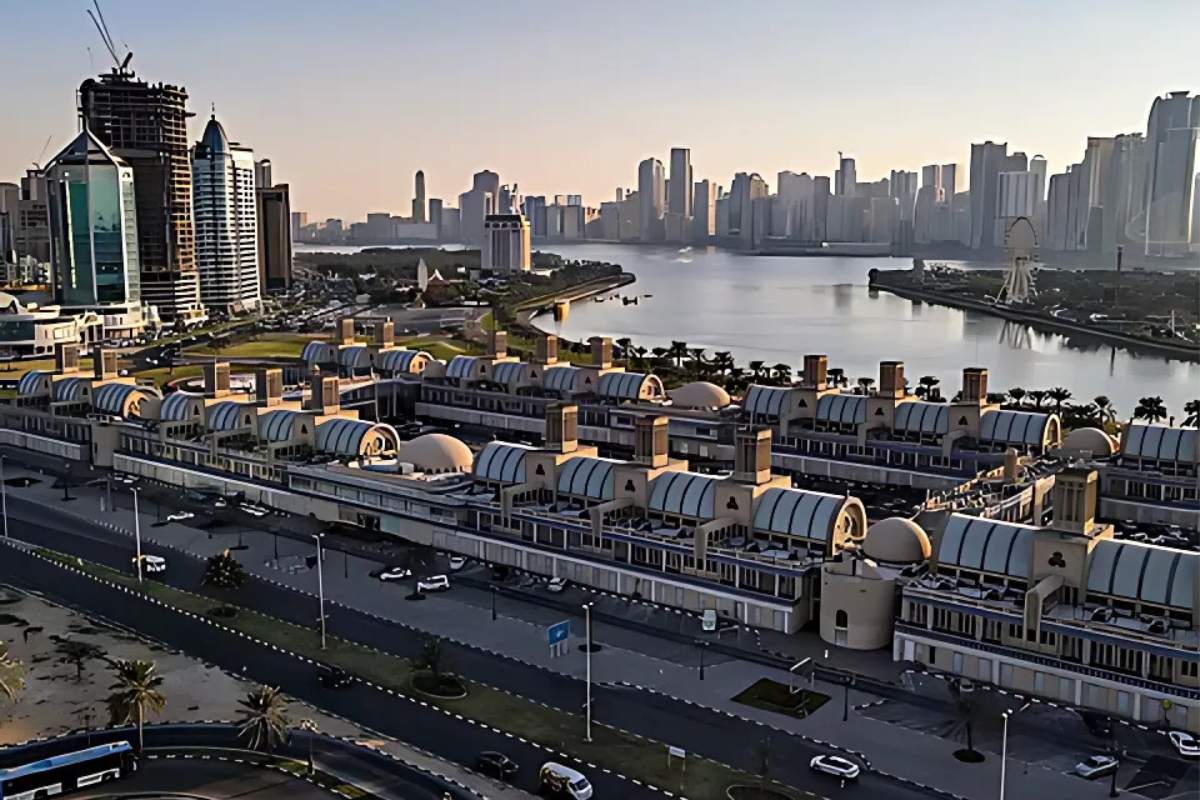Sharjah, the UAE’s third-largest emirate, has launched a strategic initiative aimed at reducing operational costs and enhancing infrastructural support to draw in small, medium, and large-scale enterprises. This package includes flexible lease terms, rental subsidies, and enhanced free‑zone offerings, all designed to position Sharjah as a compelling alternative to typically more expensive business hubs like Dubai and Abu Dhabi.
Lower Rents & Flexible Lease Terms
Cutting Lease Costs for SMEs
Commercial rents in Sharjah have traditionally been significantly more affordable than in its neighboring emirates, up to 60% cheaper according to recent data To amplify this benefit, the government, via the Sharjah Chamber of Commerce & Industry (SCCI), is actively encouraging landlords and developers to adopt reduced rental rates, longer contracts, and lease-free periods for qualifying SMEs entering the market.
Deputy Ruler’s Mandate
This push aligns with Sharjah’s 2025 budget, which allocates 41% of spending to infrastructure and 27% to economic development. These public investments signal a clear intent to build capacity while keeping operational expenses low for up-and-coming and established businesses alike.
Free‑Zone Enhancements
Strategic Updates Across Zones
Sharjah is home to several free zones, Specialized zones such as Sharjah Media City (Shams), Sharjah Publishing City (SPC), and Hamriyah Free Zone (HFZ). Each caters to diverse sectors, including media, manufacturing, logistics, and R&D, offering:
To further elevate their appeal, free zones are streamlining processes via one-stop licensing, promoting bundled packages starting from AED 5,500, and promising license issuance in as little as 72 hours
“Mazeed” Ecosystem & Integration
Sharjah Media City, under the “Mazeed” initiative, now provides integrated startup services, including financial tools, legal consultancy, and marketing support, through partnerships with tech and finance providers like Aura, Peko, and Qashio, not only simplifying setup but actively reducing recurring operational cost pressures.
Robust Infrastructure & Strategic Location
Ports, Airport, Rail Connectivity
Sharjah’s logistics appeal rests on a unique multi-modality infrastructure: dual ports on the Arabian Gulf and Gulf of Oman, an international airport, and planned rail integration under Etihad Rail. Its network reduces land and sea transit costs, critical for import-export businesses.
Projects & Capacity Expansion
The emirate has committed to power infrastructure upgrades (e.g., new waste-to-energy capacity and electric utility resilience) to minimize disruptions and ensure a consistent supply for industrial users. Free zone facilities now feature ready-to-use office spaces with high-speed internet and embedded utilities, cutting setup time to mere hours
Rising Occupancy & Real Estate Uptick
Upward Trajectory
Sharjah’s commercial real estate is shedding its “budget-alternative” status. Occupancy rates have surpassed 70% overall and topped 90% in prime developments. Rents have increased by 10–15% over the past year, with premiums climbing more than 40% on new Grade-A office spaces
Mega-Projects Stimulating Growth
- Al Thara by Sharjah Asset Management – 250,000 sq ft of office/retail + a Voco hotel, slated mid-2025
- Arada Business Park – Phase 1 to deliver 812,000 sq ft of Grade‑A office (4.3 million sq ft planned through 2027)
- District 11 by Marwan Group – a 3 million sq ft mixed-use campus
Sharjah is enhancing leasing frameworks, encouraging longer terms, and banning residential buildings from being used as offices. These regulatory steps aim to align real estate practices with global benchmarks and formalize commercial markets
Economic Momentum & Diversification
Strong Growth Outlook
The emirate’s GDP reached approximately AED 145 billion (USD 39.5 billion) in 2023, and the economy grew by ~6.5%, well above global rates. Inputs from Sharjah’s FDI office predict continued expansion of around 7–7.5% in 2025
Diversified Industry Base
Non-oil sectors, manufacturing (17%), automotive (24%), and agriculture (19%), form nearly 96% of the emirate’s economic structure, placing Sharjah firmly within broader UAE development goals The SCCI’s three-year roadmap highlights digitalization, global trade integration, and SME empowerment as pillars of future strategy
Chamber & Investment Authority Roles
- SCCI has added nearly 5,000 new members in 2023 (totaling ~45,000 active firms) and facilitated AED 17 billion in exports/re-exports
- Shurooq (Sharjah’s investment-development authority) continues to execute tourism and infrastructure initiatives (e.g., Al Noor Island, Flag Island, Heart of Sharjah), laying the groundwork for business and investment expansion
Government Initiatives & Policy Momentum
License Deregulation & Consumer Protection
Sharjah’s Economic Development Department is simplifying license cancellation and fee provisions, mirroring initial registration ease. It’s also addressing issues like credit-card surcharge abuses and improving consumer/payment protections
Fiscal Strategy & Infrastructure Spending
With 41% of its budget now allocated to infrastructure and 27% to economic development, Sharjah has underscored both short- and long-term planning. Efforts focus on sustainable growth, public-private partnerships, and long-lead projects.
Tax Incentives & Compliance Support
While federal corporate tax applies at 20%, Sharjah offers up to 100% tax exemptions for free-zone businesses until a specified profit threshold is reached. New tax frameworks allow for deductions and credit offsets, particularly for natural resources sectors.
Challenges & Risk Management
Rental Price Acceleration
Although affordable, Sharjah’s leasing market has seen surges of up to 25% for renewal tenants, opportunities, and financial friction co-exist. Without regulatory balance, this volatility could hinder startup planning.
Hidden Operational Costs
Entrepreneurs often overlook non-obvious fees, license renewals, visa processing, PRO services, utility deposits, insurance, and VAT complianceWhile Sharjah’s core offering is low‑cost, strategic planning is necessary to manage hidden overheads.
Market Absorption & Capacity
With millions of square feet of new commercial projects launching between 2025–2027, accommodating this expansion depends on sustained GDP growth, trade increases, and SME penetration. Any economic slowdown or global downturn might test developer and tenant resilience.
What This Means for Business Stakeholders

SMEs
- Cost‑sensitive ventures (tech startups, consultancies, creative firms, e-commerce) should benefit significantly from Sharjah’s reduced rental rates, extended lease terms, and affordable free‑zone bundles.
- “Mazeed”-affiliated tools, financial packages, legal assistance, and marketing services, enable lean operational structures
- Hidden cost education is critical; monitor renewal cycles and fee structures to fully benefit from the promise of affordability.
Mid‑to‑Large Enterprises
- Networks of Grade‑A commercial properties, port and airport access, and rail connectivity offer businesses realistic alternatives to Dubai, without compromising on quality or reach.
- Regulatory stability (longer leases, formal commercial zones, pro-business policies) supports long-term planning and investment confidence.
- Tax neutrality, especially inside free zones, makes Sharjah a compelling option for structuring global or regional operations.
Investors & Real Estate Developers
- Strong occupancy, rising rental values, and long-term state budgets fuel property investment momentum.
- Mega projects (Al Thara, Arada Park, District 11) offer ample commercial and residential opportunities, but also carry risks of overbuilding without commensurate demand.
- Monitoring economic tailwinds (GDP growth, trade deals, licensing records) will be critical in gauging the sustainability of returns.
Voices from the Field
“Many entrepreneurs I know chose Sharjah because they could set up and start operating in record time… budget‑friendly licenses stand out.
“Automation can help you streamline operations, reduce expenses, and boost efficiency… save thousands of dirhams annually.
“Occupancy levels are now above 70%, with prime developments exceeding 90%”, strong evidence of Sharjah’s office market revival,
Final Word
Sharjah’s proactive strategy, integrating affordable rental programs, upgraded free‑zone frameworks, and strategic public investment, aims to catalyze a sustainable business ecosystem. Its rising GDP, accelerating non-oil growth, and improving business sentiment suggest the initiative is gaining traction.
Yet, to ensure its promise endures, Sharjah must guard against cost creep (e.g. lease spikes, hidden fees), manage its surge in real estate supply wisely, and remain vigilant in protecting and simplifying SME experiences.
For business owners prioritizing affordability, flexibility, and connectivity, Sharjah’s emerging proposition offers a clear alternative to traditional business hubs. But success lies in careful planning and navigating the nuances beyond headline advantages.
Supporting Data Recap
| Key Point | Detail |
| Rent savings | Up to 60% less vs. Dubai |
| License price starts | ~AED 5,500 |
| Free‑zone features | 0% tax, full ownership & repatriation |
| Occupancy | >70%; Grade‑A at 90%+ |
| New supply | 4.3 m sq ft Arada Park (2027); District 11 3 m sq ft |
| GDP | AED 145 billion in 2023; growth ~6.5%; projected to 7.5% |
| Budget allocation 2025 | Infrastructure 41%; Economic dev 27% |
In Summary
Sharjah is staking its future on a package of affordability, speed, and infrastructure. While challenges remain, this strategic move positions it as a compelling destination for business in the Gulf region, challenging the established dominance of Dubai and Abu Dhabi, and forging its path as a business-friendly hub for the cost-conscious yet ambitious.








